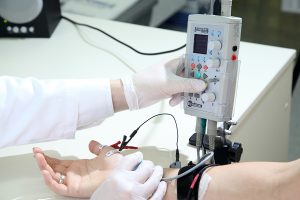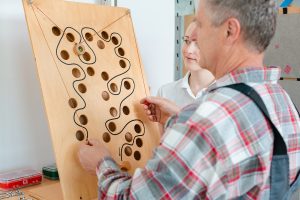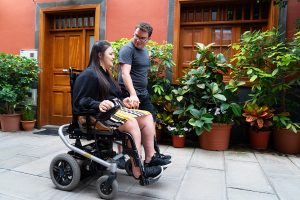This article was updated in August 2025 to reflect new developments and updated information about LGMD since its original publication in 2024.
Wondering how Limb-Girdle Muscular Dystrophy (LGMD) may affect everyday movements? Curious about what symptoms may develop over time, the therapies currently available, and what treatments are being investigated?
These are common questions for people living with LGMD, their families, and caregivers.
This blog aims to answer those questions. It offers a clear overview of LGMD and provides reliable, easy-to-understand information. The goal is to support greater understanding of LGMD, whether for individuals living with the condition, those involved in their care, or anyone seeking to learn more.
Limb-Girdle Muscular Dystrophy (LGMD) refers to a group of rare diseases that cause muscles to get weak and shrink over time. It mostly affects muscles near the center of the body, such as the shoulders, upper arms, hips, and thighs. 1, 2, 3
It is difficult to estimate how many people have Limb-Girdle Muscular Dystrophy. This is because this condition has very diverse symptoms that can look like other muscle diseases. However, research estimates that it affects around 0.8 to 6 people per 100,000 individuals worldwide. 4
Limb-Girdle Muscular Dystrophy (LGMD) is a hereditary disease, which means it can be passed down in families through changes in genes.
Different types of LGMD are caused by mutations (changes in the DNA) in specific genes. 1, 5 These genes are responsible for the formation of proteins that muscles need to function, repair, and stay healthy. When one of these genes has a mutation, the cells may not produce the protein correctly – or at all – which is necessary for healthy muscles. 1, 2, 3
Most genes come in pairs, with one copy inherited from each parent. Whether a person develops LGMD depends on how the mutated gene is inherited. There are two major groups of LGMD:
Each group includes many subtypes, depending on the specific gene affected. You can view a list of LGMD1 and LGMD2 subtypes and their associated gene mutations here.5 In addition to these subtypes, there are many cases of LGMD where the gene responsible has not yet been identified. 3
Limb-Girdle Muscular Dystrophy (LGMD) can affect people in different ways.
Symptom onset in LGMD may occur in childhood or adulthood, and both the type of symptoms and severity can vary. These differences often depend on the specific LGMD subtype. However, even people with the same subtype, including members of the same family, can experience different symptoms. 1, 3
Early LGMD signs may include walking with a waddling step. This happens when the hip and leg muscles become weak. Everyday tasks like climbing stairs, getting out of a chair, or running can become difficult. 1, 2, 3
Shoulder weakness can make it hard to:
As the disease progresses, it may change how the body looks or moves. This can include:
Other problems may appear, such as:
Diagnosing Limb-Girdle Muscular Dystrophy (LGMD) usually starts with a review of the family history and a physical exam. Doctors may ask if other family members have had muscle problems. This can help show how the condition might be passed down. A physical exam helps to determine which muscles are affected and how they are affected. 3
Several tests may be used to confirm an LGMD diagnosis:

There is no cure for Limb-Girdle Muscular Dystrophy (LGMD) yet. However, LGMD treatment can help people stay active for a longer time, manage symptoms, and feel better. 3
Treatment plans are personalized to each person’s needs and may include:
Physical therapy can help people with Limb-Girdle Muscular Dystrophy improve or maintain movement, strengthen certain muscles, and keep their joints flexible. It may also help slow muscle loss and prevent contractures, that happen when the tissues around a joint tighten and shorten, which make the joint stiff and hard to move.
Therapy may include:
Occupational therapy focuses on helping people improve their ability to perform daily tasks, including:

Assistive devices can help people with LGMD stay independent as their muscles get weaker.

Speech therapy can help people with LGMD who have slurred or unclear speech.
A speech therapist may suggest:
These techniques can make speech easier to understand during everyday conversations. 9

Some people with Limb-Girdle Muscular Dystrophy may have trouble swallowing. Weakness in the arms can also make eating harder. Together, these issues may lead to poor nutrition.
To help with swallowing, doctors or therapists may recommend:
The heart can be affected in some types of Limb-Girdle Muscular Dystrophy (LGMD), such as LGMD1B and LGMD2A–I. 7, 8
Regular check-ups can help find heart problems early. Doctors may use tests that check the heart’s rhythm, structure, and function to monitor for any changes over time.
Treatment may include medications, a pacemaker, or, in serious cases, a heart transplant. 3, 6
Some people with Limb-Girdle Muscular Dystrophy may develop breathing problems over time. This happens when the muscles that control breathing become weaker.
Doctors may monitor lung function regularly. If breathing becomes harder, they may recommend non-invasive support, such as a BiPAP machine. This device helps push air into the lungs during sleep or rest, making it easier to breathe. 3
Researchers are studying several investigational treatments for Limb-Girdle Muscular Dystrophy (LGMD). These are being tested in LGMD clinical trials and early lab studies to see if they can slow down or stop the disease. These treatments are not yet available for use in people, because their safety and effectiveness are still being evaluated. 5
Stem cells are special cells found in the body that grow into many different types of cells, including muscle cells. Scientists are exploring ways to use these cells to repair or replace muscle that has been damaged by LGMD.
There are two main types of stem cell treatments being studied:
These stem cells are injected into the person’s body, with the aim that they will turn into healthy muscle cells and help repair the damaged muscles.5
This technique is currently being tested in the laboratory. Clinical trials will be needed to evaluate the safety and effectiveness. 3, 5
Proteins help muscles grow, repair, and work properly. Exons are small sections of DNA that act like puzzle pieces, each carrying instructions for part of a protein. When put together, they help form a complete, working protein.
In some forms of Limb-Girdle Muscular Dystrophy, there are mutations in certain exons. This prevents the pieces from fitting together properly, resulting in a faulty protein that doesn’t work correctly.
Exon skipping uses small pieces of synthetic molecules to “skip over” the mutated exon when the body is making the protein. It works in this way:
This technique is being tested in the laboratory. However, no human studies have been performed yet. 3, 5
Gene delivery works by placing a healthy gene into muscle cells to replace the faulty one that causes the disease.
Scientists use delivery systems called vectors to carry the gene. The most common type is a lab-modified virus called Adeno-Associated Virus (AAV). In the lab, this virus is altered so it can carry the healthy gene and deliver it to muscle cells. It is also modified to reduce the chance of causing illness.
Once inside the muscle, the gene may help the body make the protein that was missing or not working properly. 5
This method is being tested in early clinical trials. 11, 12, 13, 14
Gene editing for Limb-Girdle Muscular Dystrophy (LGMD) works by finding a specific DNA sequence and modifying it. The most studied method is the CRISPR-Cas system. CRISPR is a system originally found in bacteria that helps them fight viruses.
This gene editing system works in some basic steps:
This technique is being tested in labs.[16] However, no human studies have been performed yet.
Some types of Limb-Girdle Muscular Dystrophy (LGMD) are caused by harmful proteins that damage muscle cells. RNA interference (RNAi) is an experimental technique designed to stop these proteins from being made.
DNA contains instructions for making proteins. Before a protein is built, the body makes a temporary copy of these instructions called messenger RNA (mRNA). The mRNA acts like a recipe that tells the cell how to make the protein.
RNA interference works like this:
By stopping harmful proteins early, RNA interference may help slow or prevent muscle damage. 5, 17
This method is still being tested in the lab. No human studies have been done yet. 5, 17
All these investigational treatments are being studied for safety and effectiveness, and may not offer direct benefit to participants. Participation in clinical trials is voluntary and subject to eligibility criteria
Limb-Girdle Muscular Dystrophy (LGMD) is an ‘umbrella’ term that includes a group of hereditary diseases that cause weakness and wasting of the muscles. It mostly affects muscles near the body’s center, like the shoulders, upper arms, hips, and thighs.
Currently, treatment for LGMD is supportive. The treatment plan is tailored to each person’s specific symptoms and may include the use of assistive devices, speech therapy, heart monitoring, respiratory care or swallowing techniques.
In the last decade, different techniques have been investigated to treat LGMD, such as stem-cell transplantation, exon skipping, gene delivery, RNAi, and gene editing. However, more investigation in clinical trials is needed to confirm their efficacy and safety.
If you want to explore clinical trial options, you can book a call with a Patient Navigator to discover your options and learn more about clinical trials.
At myTomorrows, we have a team of Patient Navigators, who are multi-lingual professionals with a medical background, who can help you to explore your treatment options and support you through your journey.
[1] MedlinePlus Muscular Dystrophy, “Limb-girdle muscular dystrophy.” Accessed: Jan. 28, 2025. [Online]. Available: https://medlineplus.gov/genetics/condition/limb-girdle-muscular-dystrophy/
[2] Cleveland, “Limb-Girdle Muscular Dystrophy.” Accessed: Jan. 27, 2025. [Online]. Available: https://my.clevelandclinic.org/health/diseases/limb-girdle-muscular-dystrophy-lgmd
[3] MDA, “Limb-Girdle Muscular Dystrophy (LGMD).” Accessed: Jan. 22, 2025. [Online]. Available: https://www.mda.org/disease/limb-girdle-muscular-dystrophy/
[4] D. G. Georganopoulou et al., “A Journey with LGMD: From Protein Abnormalities to Patient Impact,” The Protein Journal 2021 40:4, vol. 40, no. 4, pp. 466–488, Jun. 2021, doi: 10.1007/S10930-021-10006-9.
[5] C. Bouchard and J. P. Tremblay, “Limb–Girdle Muscular Dystrophies Classification and Therapies,” J Clin Med, vol. 12, no. 14, p. 4769, Jul. 2023, doi: 10.3390/JCM12144769.
[6] “Limb-girdle muscular dystrophies,” 2017.
[7] MDA, “What about exercise with LGMD? .” Accessed: Jan. 22, 2025. [Online]. Available: https://www.mda.org/quest/article/what-about-exercise-with-lgmd
[8] “Occupational Therapy: What It Is, Different Types & Benefits.” Accessed: Aug. 01, 2025. [Online]. Available: https://my.clevelandclinic.org/health/treatments/occupational-therapy
[9] “Speech Therapy | Muscular Dystrophy News.” Accessed: Aug. 01, 2025. [Online]. Available: https://musculardystrophynews.com/speech-therapy/
[10] “What is exon skipping and how does it work? – Muscular Dystrophy UK.” Accessed: Aug. 01, 2025. [Online]. Available: https://www.musculardystrophyuk.org/research/what-is-exon-skipping-and-how-does-it-work/
[11] “Atamyo Therapeutics Obtains US FDA Fast Track Designation for ATA-100, a Gene Therapy in Phase 1/2 Clinical Trials for Limb-Girdle Muscular Dystrophy Type R9 (LGMD-R9) – Atamyo Therapeutics.” Accessed: Aug. 01, 2025. [Online]. Available: https://atamyo.com/press-releases/atamyo-therapeutics-obtains-us-fda-fast-track-designation-for-ata-100-a-gene-therapy-in-phase-1-2-clinical-trials-for-limb-girdle-muscular-dystrophy-type-r9-lgmd-r9/
[12] “Sarepta Therapeutics’ Limb-Girdle Muscular Dystrophy Gene Therapy SRP-9003 Shows Safety in 5-Year Data.” Accessed: Aug. 01, 2025. [Online]. Available: https://www.cgtlive.com/view/sarepta-therapeutics-limb-girdle-muscular-dystrophy-gene-therapy-srp-9003-safety-5-year-data
[13] “AskBio Advances Gene Therapy Clinical Trial for Limb-Girdle Muscular Dystrophy Type 2I/R9 with Dosing of First Participant in Second Cohort – AskBio.” Accessed: Aug. 01, 2025. [Online]. Available: https://www.askbio.com/askbio-advances-gene-therapy-clinical-trial-for-limb-girdle-muscular-dystrophy-type-2i-r9-with-dosing-of-first-participant-in-second-cohort/
[14] “Trial of AB-1003 for LGMD proceeds after positive recommendation.” Accessed: Aug. 01, 2025. [Online]. Available: https://musculardystrophynews.com/news/trial-ab-1003-lgmd-proceeds-positive-recommendation/
[15] M. Redman, A. King, C. Watson, and D. King, “What is CRISPR/Cas9?,” Arch Dis Child Educ Pract Ed, vol. 101, no. 4, p. 213, Aug. 2016, doi: 10.1136/ARCHDISCHILD-2016-310459.
[16] “Gene-editing therapy for LGMD shows promise in mouse model.” Accessed: Aug. 01, 2025. [Online]. Available: https://musculardystrophynews.com/news/gene-editing-therapy-lgmd-shows-promise-mouse-model/
[17] “RNA Interference | Muscular Dystrophy News.” Accessed: Aug. 01, 2025. [Online]. Available: https://musculardystrophynews.com/rna-interference/
| Subtype | Gene | Protein |
| LGMD1A | MYOT | Myotilin |
| LGMD1B | LMNA | Lamin A/C |
| LGMD1C | CAV3 | Caveolin 3 |
| LGMD1D (LGMDD1) | DNAJB6 | DNAJ homologue, family B, member 6 |
| LGMD1E | DES | Desmin |
| LGMD1F (LGMDD2) | TNPO3 | Transportin 3 |
| LGMD1G (LGMDD3) | HNRNPDL | Heterogenous nuclear ribonucleoprotein D-like |
| LGMD1H | unknown | unknown |
| LGMD1I (LGMDD4) | CAPN3 | Calpain 3 |
| Bethlem Myopathy Dominant (LGMDD5) | COL6A1, COL6A2, COL6A3 | Collagen 6 |
| Subtype | Gene | Protein |
| LGMD2A (LGMDR1) | CAPN3 | Calpain 3 |
| LGMD2B (LGMDR2) | DYSF | Dysferlin |
| LGMD2C (LGMDR5) | SGCG | γ-Sarcoglycan |
| LGMD2D (LGMDR3) | SGCA | α-Sarcoglycan |
| LGMD2E (LGMDR4) | SGCB | β-Sarcoglycan |
| LGMD2F (LGMDR6) | SGCD | δ-Sarcoglycan |
| LGMD2G (LGMDR7) | TCAP | Telethonin |
| LGMD2H (LGMDR8) | TRIM32 | Tripartite motif-containing protein 32 |
| LGMD2I (LGMDR9) | FKRP | Fukutin-related protein |
| LGMD2J (LGMDR10) | TTN | Titin |
| LGMD2K (LGMDR11) | POMT1 | Protein O-mannosyltransferase 1 |
| LGMD2L (LGMDR12) | ANO5 | Anoctamin 5 |
| LGMD2M (LGMDR13) | FKTN | Fukutin |
| LGMD2N (LGMDR14) | POMT2 | Protein O-mannosyltransferase 2 |
| LGMD2O (LGMDR15) | POMGnT1 | Protein O-mannose beta-1,2-N-acetylglucosaminyltransferase |
| LGMD2P (LGMDR16) | DAG1 | Dystroglycan |
| LGMD2Q (LGMDR17) | PLEC1 | Plectin |
| LGMD2R | DES | Desmin |
| LGMD2S (LGMDR18) | TRAPPC11 | Transport protein particle complex 11 |
| LGMD2T (LGMDR19) | GMPPB | GDP-mannose pyrophosphorylase B |
| LGMD2U (LGMDR20) | ISPD | Isoprenoid synthase |
| LGMD2V | GAA | α-1,4-Glucosidase |
| LGMD2W | LIMS2 | Lim and senescent cell antigen-like domains 2 |
| LGMD2X (LGMDR25) | BVES | Popeye domain containing protein 1 (POPDC1) |
| LGMD2Y | TOR1A1P1 | Torsin 1A-interacting protein 1 |
| LGMD2Z (LGMDR21) | POGLUT1 | Protein O-glucosyltransferase 1 |
| Bethlem Myopathy Recessive (LGMDR22) | COL6A1, COL6A2, COL6A3 | Collagen 6 |
| Laminin α2-related Muscular Dystrophy (LGMDR23) | LAMA2 | Laminin α2 |
| POMGNT2-related Muscular Dystrophy (LGMDR24) | POMGnT2 | Protein O-linked Mannose β-1,4-N-Acetylglucosaminyl-transferase 2 |
Source: Bouchard C and Tremblay JP. 2023.
About the author
Medical Content Writer at myTomorrows
Dr. Andrea Enguita Marruedo holds a master’s in Genetics and Cell Biology from the Autonomous University of Madrid and a PhD in Developmental Biology from the Erasmus Medical Centre in Rotterdam. She began her career in medical writing after completing her doctoral studies and has covered a wide range of therapeutic areas, including neuromuscular and neurodegenerative disorders, cancer, and diabetes.
Andrea specializes in translating complex biomedical topics into clear, accessible content for patients and healthcare professionals. With a strong research background and a passion for science communication, she is committed to delivering accurate, well-referenced content that supports greater awareness and understanding of medical topics among patients, caregivers, and clinicians.
Andrea Enguita 17 Sep 2024